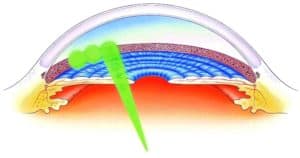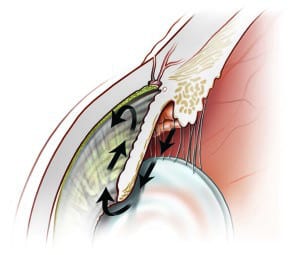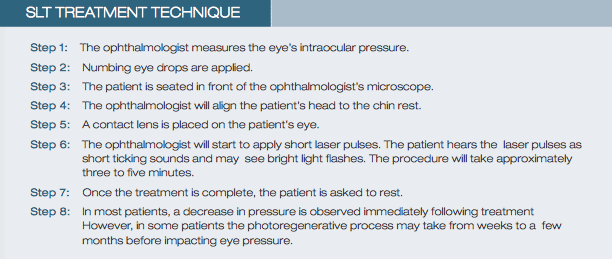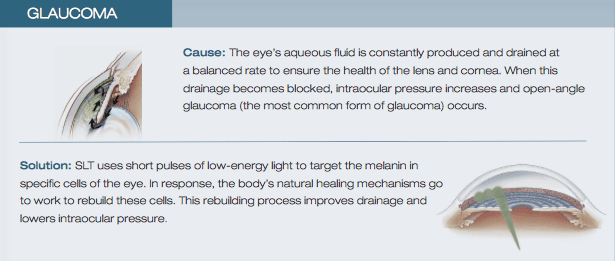Selective Laser Trabeculoplasty – SLT

Selective Laser Trabeculoplasty or SLT is a new, innovative laser-based procedure that successfully lowers intraocular pressure. In comparison to other antiquated treatments, SLT is repeatable, non-invasive and does not result in any major side effects. Hundreds of thousands of patients have already gained relief from this non-invasive, gentle procedure.

The most common form of glaucoma is Open-Angle Glaucoma. When the eye’s aqueous fluid is no longer produced and drained at a balanced rate, risking the health of the lens and cornea, intraocular pressure develops in the eye leading to discomfiture due to pressure, and the eventual loss of vision.
Patient Education
Have Questions? Need More Information?
The Eye Professionals At SNEAD EYE GROUP Are Ready To Help You Now!


Selective Laser Trabeculoplasty, or SLT,is a form of laser surgery that is used to lower intraocular pressure in glaucoma. It is used when eye drop medications are not lowering the eye pressure enough or are causing significant side effects. It may sometimes be used as initial treatment in glaucoma.
SLT has been in use for 12 years in the United States and around the world.
- Who is a candidate for SLT? Patients who have open-angle glaucoma (the drainage system in the front part of the eye is open) and are in need of lowering of their intraocular pressure (IOP) are eligible for the procedure. Your eye doctor will make the final determination if you are a candidate.
- How does it work? Laser energy is applied to the drainage tissue in the eye. This starts a chemical and biological change in the tissue that results in better drainage of fluid through the drain and out of the eye. This eventually results in lowering of IOP. It may take 1-3 months for the results to appear.
- Why is it called Selective? The type of laser used has minimal heat energy absorption because it is only taken up by selected pigmented tissue in the eye. Sometimes it is referred to as a “cold laser.” Because of this, the procedure produces less scar tissue and has minimal pain.
- What are the risks? One key aspect of SLT is a favorable side effect profile, even when compared with glaucoma medications. Post-operative inflammation is common but generally mild, and treated with observation or eye drops or an oral non-steroidal anti-inflammatory drug. There is an approximately 5% incidence of IOP elevation after laser, which can be managed by glaucoma medications and usually goes away after 24 hours.
- How effective is it? SLT lowers the IOP by about 30% when used as initial therapy. This is comparable to theIOP lowering of the most powerful and commonly used class of glaucoma medication (prostaglandin analogs). This effect may be reduced if the patient is already on glaucoma medications.
- How long does the effect last? The effect will generally last between 1-5 years, and in rare cases, longer than that. If it does not last at least 6-12 months, it is usually not considered successful.
- What happens if it wears off? If SLT is effective at lowering IOP but this wears off over several years, the procedure can be repeated But the second treatment may not be as effective as the first and may not last as long. If SLT is not initially successful, repeat treatment is not likely to be effective. Alternatively, glaucoma medication can be used if the effect wears off over time.
- What happens if it doesn’t work? If SLT fails to lower the IOP, then the glaucoma is treated by other means such as medications or conventional surgery. The laser does not affect the success of these other types of treatment.
- What is the cost? Since the procedure is an accepted glaucoma treatment, and is FDA approved, it is covered by Medicare and medical insurance. The cost for an uninsured individual or with an insurance co-pay will vary.
- Will I still need to use glaucoma medications? Some patients can be controlled with just laser treatment. Others require additional IOPlowering and may therefore need to use glaucoma medication as well. Think of the SLT as equivalent to one glaucoma medication. Just as some patients will require more than one glaucoma medication to control their IOP, some may also require laser plus one or more glaucoma medications. It is important to remember that SLT is not a cure for glaucoma, just as medication and surgery are not. Whatever method is used to treat glaucoma, appropriate follow up and testing with your eye care professional is critical.
CONVENIENT LOCATIONS
Convenient eyecare and surgical centers throughout Southwest Florida
SCHEDULE YOUR APPOINTMENT
Don’t wait to get your examination. Schedule your optical appointment today
FINANCING AVAILABLE
Pay for medical expenses not covered by insurance with CareCredit
PATIENT EDUCATION